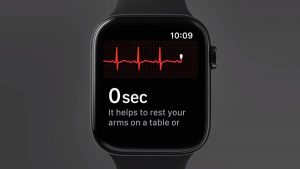The newest Apple Watch has arrived. Updated, new, and shiny, the Series 4 watch offers a state-of-the-art heart monitor feature that can alert users of potential heart problems, according to IEEE Spectrum. The app, cleared by the Food and Drug Administration, works like an electrocardiogram, allowing wearers to proactively manage their health. Electrodes on the back of the watch and on the watch band allow wearers to detect irregular heart rhythms that can warn consumers of any possible atrial fibrillation’s that could possibly lead to blood clots or strokes; heart disease being one of the top killers in the western world. The Series 4 Apple Watch is truly unique; the first certified ECG monitor to be sold over the counter, directly to consumers.
The Good
Of course, as with all things, the feature offers a good side and bad side. First, the good. The Apple Watch offers developments no other heart rate tracker has before. For example, patients who are already aware of heart problems can have their doctor monitor their condition from a distance, as the watch not only displays results instantaneously, it also stores the full ECG report as a PDF on the user’s iPhone, capturing data in real time. This very information can also warn users of heart problems they were may have not been aware of in the first place, allowing for early diagnoses and preventive measures to be taken.
The Bad
At the same time, the accessibility and misinterpretation of this data is a growing to concern with cardiologists. What a user may interpret as an abnormal reading, might actually be perfectly normal.
The truth is, everyone has their own, unique heart rhythm which varies. False emergencies, false positives, false negatives, and unnecessary testing has the potential to mislead users, and worse, send them into a panic about a problem that isn’t there.
“People are scared; their heart scares them,” says John Mandrola, a cardiologist at Baptist Health in Louisville.
The Middle Ground
Overall, the heart monitoring feature is an instrumental addition, if used correctly. It’s also important to keep in mind, the data does not offer the same insight and depth as a hospital recorded ECG.
James D. Burgess, a professor of medical laboratory science at Augusta University and longtime ECS member, explains that an actual ECG collects data from multiple electrodes placed on the chest and around the heart.
“And so as the heart muscle beats, there are electrical signals that occur when that happens from the muscle contractions. And so they sense kind of this shifting dipole from the muscle heartbeat,” says Burgess, “while the Apple Watch uses a pure electrical (voltage) reading with sophisticated analysis software,” noting the reason why the FDA warns of possible false positive irregular rhythms.
One thing is clear, researchers are continuously pushing the boundaries of biosensors. From features that track sleep, calories burned, BMI, and more, this is just the beginning



